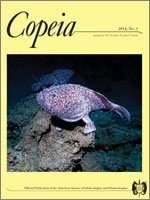We investigate whether Taricha granulosa, the rough-skinned newt, possesses pheromone-producing courtship glands in the submandibular dermis. The hypothesis that these newts have a pheromone-producing mental gland repeatedly appears in the literature based on a small histological study and on courtship behavior in which males press their chins on females' nares. We identify a sexually dimorphic granular gland in the submandibular region of male newts. Its secretion is granular and PAS (periodic acid-Schiff)-positive, in contrast to the PAS-negative secretion of typical granular glands. This gland type is found only in males and only in the anterior submandibular region. Compared to glands evaluated from non-breeding males, the glands from animals collected in the breeding season are hypertrophied. This sexually dimorphic granular gland is distinct from the mental gland found in plethodontid salamanders; the plethodontid mental gland is an aggregate of individual glands, whereas the granular glands in T. granulosa are not clustered together to form a distinct unit. Our results support the hypothesis that males are secreting pheromones from submandibular glands during courtship in T. granulosa.
How to translate text using browser tools
1 March 2014
The Presence of Sexually Dimorphic Submandibular Glands in Taricha granulosa, the Rough-Skinned Newt (Salamandridae)
Scott R. Hippe,
Catherine R. Propper,
Nancy L. Staub
ACCESS THE FULL ARTICLE





